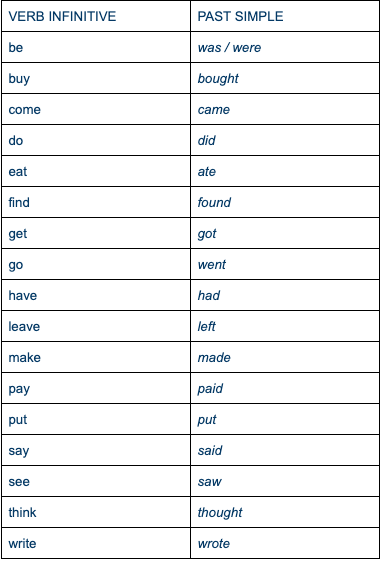Learning to Use the Past Simple in English
04 Nov 2019
Have you ever wanted to describe a past situation in English and didn’t know how to do it? The past simple is one of the most used verb tenses in English along with the present simple and present continuous, so it’s important to understand how to use it. Once you know the past simple it’s much easier to have a conversation and communicate clearly to the person you’re talking to.
So let’s look at how to use this verb tense.
When is the past simple used?
The past simple has several uses:
- to talk about actions that were carried out in the past and that have already ended.
For example, “I had dinner with my friends yesterday.”
- to describe a series of past actions
For example, “I received the good news and immediately called my family.”
- to talk about repeated and habitual actions in the past
For example, “She always travelled to Miami on vacation when she was a child.”
- to talk about general situations and facts in the past
For example, “Michael Jackson died in 2009.”
- to describe stories and actions that lasted a long time
For example, “He didn’t find a job for years.”
The Structure
Affirmative sentences
The basic structure of the past simple is:
Subject + past tense + object
So all you need to do is to put the verb in its past form. There are two types of verbs – regular and irregular.
Regular verbs are easy because you simply have to add -ed, -d, or -ied.
- for verbs ending in most consonants, add -ed
- for verbs ending in -e, add -d
- for verbs ending in -y, change to -i and add -ed
For example,
I visited my family last summer.
He changed his job in February.
You studied architecture at University.
Irregular verbs don’t follow a rule and often completely change their form. In this case you have to learn and remember them. Here are some of the most common irregular verbs:

For example,
I bought this car last summer.
She went to the cinema yesterday.
As you can see, there are two forms of the verb ‘to be’ in the past – was for the subjects I, he, she and it, and were for the subjects you, we and they. For example,
He was sick at the weekend.
They were late and missed their flight.
Negative sentences
In the simple past negative sentences are created by using the auxiliary ‘did’ with ‘not’ – didn’t. The structure is:
Subject + didn’t + verb (infinitive form) + object
For example:
I didn’t pass the exam.
The structure is the same for all subjects.
Interrogative sentences
As you know, we add ‘do’ at the start of the basic structure to make questions in the present simple. It’s similar in the past simple, but in this case we add ‘did’ (the past of ‘do’).
Did + subject + verb (infinitive form) + object
For example:
Did you go to the theater last weekend?
Adverbs
In most tenses, whether in the present, past or future, we use adverbs. Adverbs help us define and understand when something happened or will happen. Knowing what adverbs mean will really help you understand dialogues and texts. Here are some common time adverbs:
- Yesterday – the day before today
- Last year/week/night – the previous year/week/night
- Five minutes ago – five minutes before now
- Late – after the expected time
Here are some examples:
Did you stay at home last night? No, we went to the cinema.
They merged with another company last year.
Mr Jones arrived five minutes ago.
His train was late.
If you want to speak English well, it’s essential to know the most common verb tenses, including the past simple.
At Wall Street English you can learn all the verb tenses in a practical and fun way through listening and speaking. Our method of interactive learning and speaking time in small classes with a native English teacher enables you to quickly become confident in using English.
Are you ready to see how well you know the past simple? Try this fun quiz!
This post has been adapted and translated from the original content by WSE Argentina here: Aprendé a escribir oraciones en inglés en pasado simple